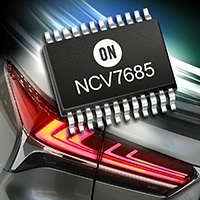 ON Semiconductor has launched a new family of four devices that facilitate the high levels of performance and innovative functionality that vehicle manufacturers and consumers now expect from automotive exterior and interior lighting. Aimed specifically at low power solid state lighting, the new family comprises two LED drivers (NCV7683 and NCV7685) and two current controllers (NCV7691 and NCV7692).
ON Semiconductor has launched a new family of four devices that facilitate the high levels of performance and innovative functionality that vehicle manufacturers and consumers now expect from automotive exterior and interior lighting. Aimed specifically at low power solid state lighting, the new family comprises two LED drivers (NCV7683 and NCV7685) and two current controllers (NCV7691 and NCV7692).
In the pursuit of improved road safety, automakers are moving away from the simple ‘on/off’ operation to sophisticated systems that incorporate movement and variable intensity within rear combination lamps (RCLs), turn signals, fog lamps, and other externally modulated LED clusters to give clearer and highly visible warnings to other road users.
The NCV7685 and NCV7683 integrate twelve and eight linear programmable current sources, respectively, enabling multiple strings of LEDs to be driven with up to 100 mA per channel. The devices provide an array of configurability options, including daisy-chaining, illumination level control, current regulation, sequencing functionality, and channel combination. The NCV7685 incorporates an 8-bit I2C interface with CRC8 error detection for individual output current adjustment via pulse width modulation (PWM), and for advanced diagnostics – including detection of an open LED string or under voltage condition – a dedicated diagnostic pin is also available. The NCV7685 may be powered with a DC-DC controller and/or LDO voltage regulator, depending upon specific design requirements.
The NCV7691 provides a regulated wide current range for driving LEDs in one or multiple strings, with only an external NPN bipolar transistor (and a feedback resistor. The driver provides design flexibility to add additional single channels to multichannel systems, and supports a dimming function via its PWM input. The NCV7691 includes open string, short circuit, and thermal shutdown, ensuring safe and reliable operation of essential lighting. The derivative NCV7692 offers a faster response time and a reduced threshold for open load detection.


Leave a Reply